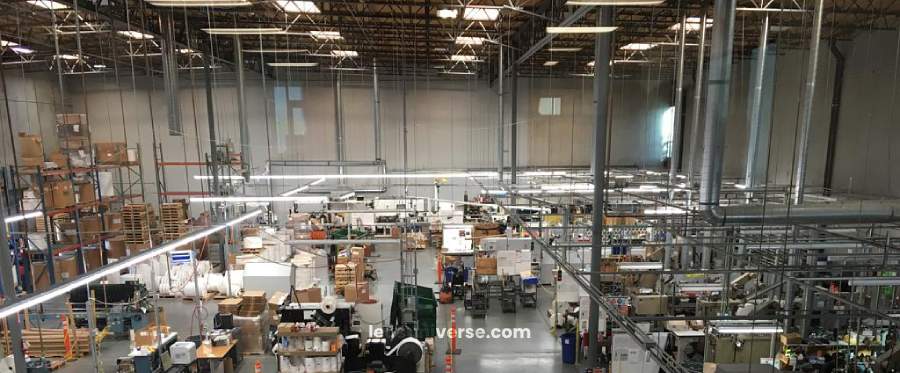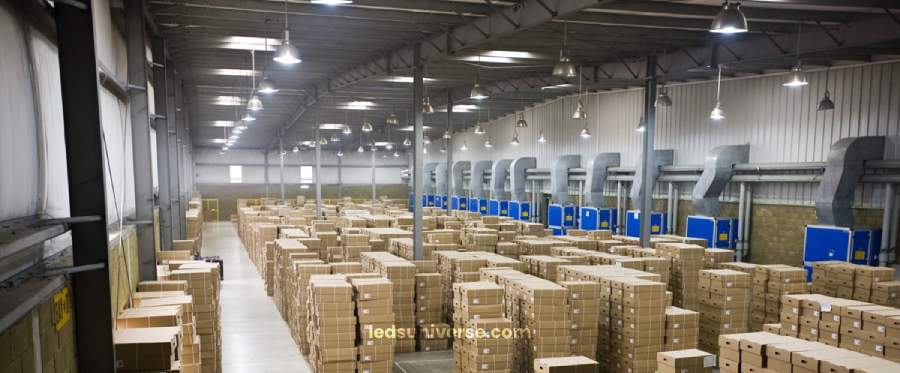Lighting is about creating an environment that enhances productivity, safety, and operational efficiency. From optimizing brightness levels to integrating smart controls, the future of warehouse lighting promises to revolutionize the way we work, making every task clearer and every workspace safer.
Proper lighting not only enhances visibility but also contributes to a productive work environment. We will explore key aspects of warehouse lighting, including lux levels and brightness, durability and maintenance, and lighting design considerations.
Reach out for free lighting consultation
Table of Contents
Toggle
Lux levels quantify the intensity of light reaching a surface, a crucial factor in optimizing warehouse lighting. This measurement is vital because it directly impacts how well tasks can be performed, how comfortable the working environment is, and how efficiently operations run.
In a warehouse setting, achieving the appropriate lux levels is essential for various activities, ranging from routine storage operations to complex assembly processes. Different areas within a warehouse have different lighting needs. For general storage spaces where detailed work is minimal, a lux level between 100 and 200 is usually adequate. This level of illumination ensures that goods are visible and accessible without causing excessive glare or shadows.
However, more specialized areas, such as those involving intricate tasks or inspections, require higher lux levels to ensure precision and accuracy. In these cases, lux levels ranging from 300 to 500 or even higher may be necessary to provide clear visibility and reduce the risk of errors. Furthermore, the distribution of light across the warehouse is just as important as the overall lux level. Uneven lighting can create dark spots and areas of excessive brightness, leading to visual discomfort and decreased efficiency.
Brightness, or the amount of light emitted by a fixture, plays a pivotal role in creating an effective and productive warehouse environment. Adequate brightness is essential not only for performing tasks efficiently but also for ensuring worker safety and comfort. Inadequate lighting can lead to visual fatigue, reduced productivity, and increased risk of accidents due to poor visibility.
Modern LED lighting systems offer significant advantages over traditional lighting sources in terms of brightness and energy efficiency. LEDs are designed to provide high levels of brightness while consuming less power compared to conventional lighting options such as High-Pressure Sodium (HPS) lamps or fluorescent bulbs. This efficiency translates into brighter and more consistent lighting throughout the warehouse, enhancing visibility and overall working conditions.
Moreover, LED lights are highly versatile and can be tailored to meet specific lighting needs within the warehouse. For instance, adjustable LED fixtures allow for precise control of brightness levels, enabling warehouses to customize lighting according to the demands of different tasks or operational areas. This adaptability ensures that the lighting system can evolve with the warehouse’s needs, maintaining optimal performance over time.
In addition to improving visibility, the energy efficiency of LED lighting contributes to significant cost savings. By consuming less electricity and reducing heat generation, LED lights lower energy bills and minimize the load on cooling systems. This not only benefits the warehouse’s bottom line but also supports environmental sustainability efforts by reducing overall energy consumption.

Designing an effective lighting layout in a warehouse is a multifaceted task that involves careful planning and strategic placement of lighting fixtures. The primary objective is to achieve uniform illumination across the entire warehouse to enhance visibility and operational efficiency while preventing issues such as shadows and dark spots that can impede productivity and safety.
One of the first steps in designing a lighting layout is to conduct a thorough assessment of the warehouse’s layout and operational needs. This includes mapping out the location of racks, storage areas, and workstations, as well as considering the types of tasks performed in each area. For example, high-traffic areas and workstations that require detailed work might need brighter, more focused lighting, while storage areas can be illuminated with less intense light.
Proper lighting design ensures that light is distributed evenly throughout the space, minimizing areas of poor visibility and excessive brightness. This can be achieved through the strategic placement of fixtures and the use of lighting techniques such as layering, where different types of lighting (e.g., ambient, task, and accent) are combined to create a well-balanced illumination. Additionally, using fixtures with wide beam angles can help cover larger areas and reduce the likelihood of shadows.
Another important consideration is the height at which lighting fixtures are installed. In warehouses with high ceilings, high bay lights are often used to provide adequate coverage from above. In contrast, lower-ceiling warehouses might benefit from different types of fixtures or mounting techniques. The goal is to ensure that every corner of the warehouse is well-lit, which helps improve overall safety and efficiency.
Energy efficiency is a critical aspect of warehouse lighting design, especially given the large scale and extended operating hours typical of warehouse environments. The choice of lighting technology plays a significant role in determining energy consumption and operational costs. LED lighting has emerged as a leading solution due to its high efficiency and substantial cost savings.
LED lights are known for their ability to produce high levels of illumination while consuming significantly less power compared to traditional lighting sources such as High-Pressure Sodium (HPS) lamps or fluorescent bulbs. This efficiency translates into lower electricity bills, which can be particularly beneficial for warehouses where lighting accounts for a significant portion of energy expenses.
Moreover, the energy efficiency of LED lights is not only about reducing electricity consumption. LEDs also generate less heat than traditional lighting sources, which reduces the load on cooling systems and further contributes to cost savings. This lower heat output helps maintain a more stable temperature within the warehouse, which can be advantageous for both workers and sensitive inventory.
In addition to financial savings, energy-efficient lighting solutions align with broader sustainability goals. By reducing energy consumption and minimizing environmental impact, warehouses can contribute to a more sustainable future. Many organizations are now prioritizing energy-efficient lighting as part of their corporate social responsibility (CSR) initiatives, recognizing the importance of reducing their carbon footprint.
Modern lighting systems are increasingly equipped with advanced controls and sensors that enhance their functionality and efficiency. These smart lighting solutions offer the ability to adjust brightness levels based on various factors, including occupancy and ambient light conditions. This adaptability helps optimize energy use and improve the overall performance of the lighting system.
One key feature of smart lighting systems is the use of motion sensors. These sensors detect movement within a space and adjust the lighting accordingly. For example, in areas of the warehouse that are infrequently accessed, motion sensors can reduce lighting levels or turn off lights entirely when no movement is detected. This approach ensures that energy is not wasted on lighting unoccupied areas, contributing to overall energy savings.
Daylight sensors are another valuable component of modern lighting systems. These sensors measure the amount of natural light entering the warehouse and adjust the artificial lighting accordingly. During daylight hours, the sensors can dim or turn off artificial lights to take advantage of the natural light, while during darker periods, they can increase the intensity of artificial lights to maintain consistent illumination levels.
The integration of these advanced controls not only enhances energy efficiency but also improves the convenience and functionality of the lighting system. Automated adjustments based on real-time conditions ensure that lighting levels are always appropriate for the task at hand, reducing the need for manual adjustments and ensuring a more comfortable working environment.
LED warehouse lights offer high coverage and bright illumination, which is essential for the large spaces typical of warehouses. These lights provide uniform lighting across expansive areas, ensuring that all sections of the warehouse are well-lit. The high brightness levels offered by LEDs improve visibility and operational efficiency, making them a superior choice compared to traditional lighting solutions.
One of the most significant advantages of LED lighting is its energy efficiency. LED lights use less electricity than traditional lighting sources, resulting in lower energy costs. This is particularly beneficial for warehouses, where lighting can account for a substantial portion of energy expenses. By switching to LED lighting, warehouses can achieve substantial savings on their electricity bills.
LED lights operate at a lower temperature than conventional lighting options. This cooler operation reduces the need for additional cooling systems, such as air conditioners, which can be costly to maintain. By generating less heat, LED lights contribute to a more comfortable working environment and further reduce overall energy consumption.
LED lights are also safer compared to traditional bulbs. They do not contain hazardous materials like mercury, which is commonly found in fluorescent lamps. Additionally, LED lights are more durable and resistant to breakage, reducing the risk of injuries and ensuring a safer workplace. Their long lifespan also means fewer replacements and less frequent maintenance, adding to their overall safety and reliability.
Lux levels and brightness play crucial roles in ensuring adequate visibility for various tasks, while durability and maintenance considerations are vital for long-term performance. Proper lighting design, including energy-efficient solutions like LED lights, further optimizes warehouse operations.
LED lighting solutions from LedsUniverse offer numerous advantages, including high coverage, low electricity costs, cooler operation, and enhanced safety. As warehouses continue to seek ways to improve efficiency and reduce costs, LED lighting stands out as a superior choice that delivers both performance and sustainability. By investing in advanced lighting solutions, warehouses can achieve a well-lit, safe, and cost-effective environment that supports their operational goals.